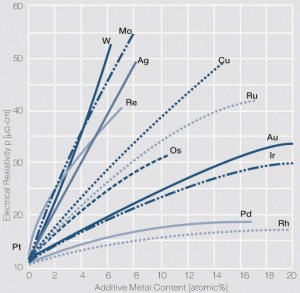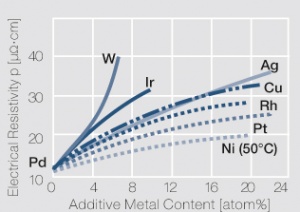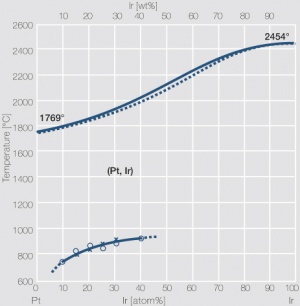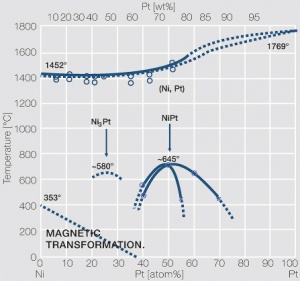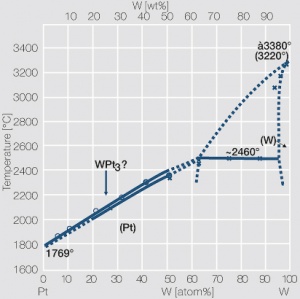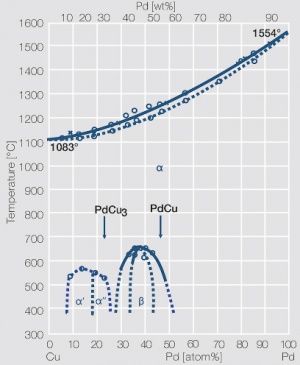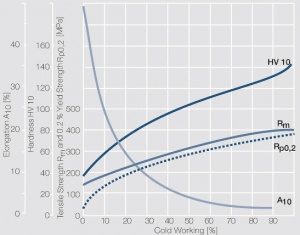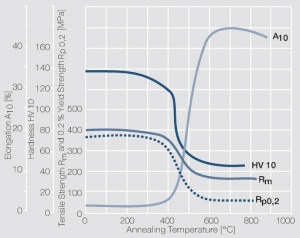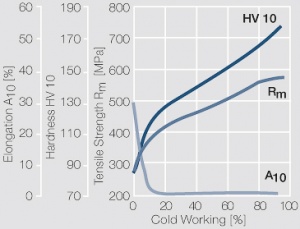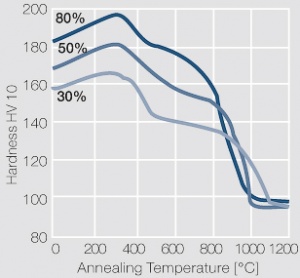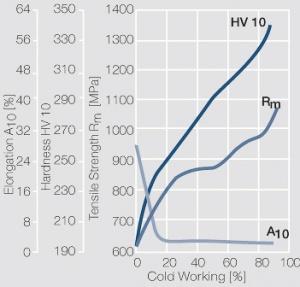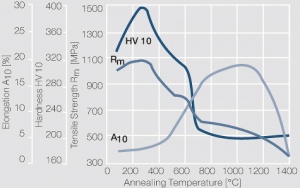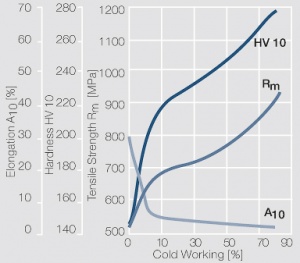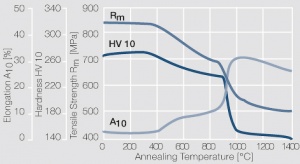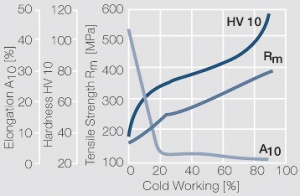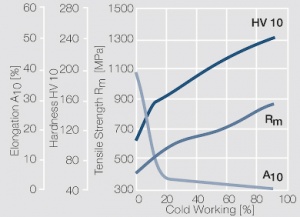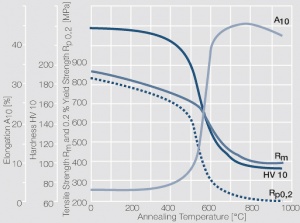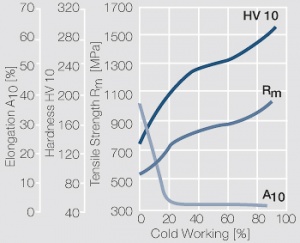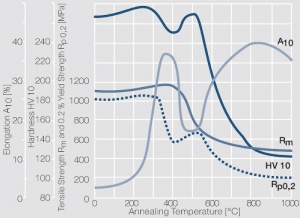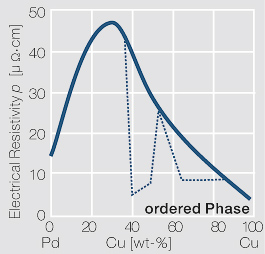Difference between revisions of "Werkstoffe aus Platin-Metallen"
Teitscheid (talk | contribs) (temp edit) |
Teitscheid (talk | contribs) (temp edit) |
||
| Line 71: | Line 71: | ||
</figtable> | </figtable> | ||
| − | + | Heute werden diese Werkstoffe aus | |
| + | Preisgründen nur noch selten verwendet. Pd-Legierungen haben dagegen | ||
| + | wesentlich größere Bedeutung. So ist z.B. PdCu15 für Blinkgeber im Kfz weit | ||
| + | verbreitet. PdAg-Legierungen werden aufgrund ihrer Beständigkeit gegenüber | ||
| + | Sulfidbildung in der Relaistechnik häufig eingesetzt. Thermisch aushärtbare | ||
| + | Mehrkomponentenlegierungen z.B. auf PdAgAuPt-Basis kommen aufgrund ihrer | ||
| + | herausragenden mechanischen Eigenschaften in Gleitkontaktsystemen zur Anwendung. | ||
| + | Pd44Ag38Cu15 PtAuZn gilt dabei als Standardlegierung dieser | ||
| + | Werkstoffgruppe (<xr id="tab:Mechanical_Properties_of_the_Platinum_Metals_and_their_Alloys"/><!--(Tab 2.8)--> und <xr id="tab:Contact_and_Switching_Properties_of_the_Platinum_Metals_and_their_Alloys"/><!--(Tab. 2.9)-->). | ||
| − | + | Platin- und Palladium-Legierungen kommen ähnlich wie Gold-Legierungen | |
| + | üblicherweise als geschweißte Draht- und Profilabschnitte, seltener als | ||
| + | Kontaktniete zum Einsatz. Aufgrund der sehr hohen Edelmetallpreise werden | ||
| + | solche Verbindungsverfahren verwendet, bei denen ein sparsamer Edelmetalleinsatz | ||
| + | gewährleistet ist. Platin- und Palladium-Werkstoffe werden wegen ihrer | ||
| + | Beständigkeit gegenüber Materialwanderung in Gleichstromkreisen und ihrer | ||
| + | verglichen mit Gold-Legierungen höheren Abbrandfestigkeit in Relais und | ||
| + | Schaltern bei mittlerer elektrischer Belastung bis etwa 30 Watt eingesetzt (<xr id="fig:Application_Examples_and_Form_of_Supply_for_Platinum_Metals_and_their_Alloys"/><!--(Table 2.10)-->). Mehrkomponentenlegierungen auf Pd-Basis finden wegen ihrer hohen | ||
| + | mechanischen Verschleißfestigkeit verbreitet Anwendung als Schleiffedern in | ||
| + | Gleitkontaktsystemen und Gleichstrom-Kleinstmotoren. | ||
<figtable id="tab:Mechanical_Properties_of_the_Platinum_Metals_and_their_Alloys"> | <figtable id="tab:Mechanical_Properties_of_the_Platinum_Metals_and_their_Alloys"> | ||
| − | <caption>''' | + | <caption>'''Festigkeitseigenschaften von Platin-Metallen und deren Legierungen'''</caption> |
<table class="twocolortable"> | <table class="twocolortable"> | ||
<tr> | <tr> | ||
| − | <th rowspan="2"> | + | <th rowspan="2">Werkstoff</th><th colspan="2">Zugfestigkeit [MPa]</th><th colspan="2">Dehnung A [%]</th><th colspan="2">Vickershärte HV 1</th></tr> |
| − | <tr><th> | + | <tr><th>weich</th><th>70% verformt</th><th>weich</th><th>70% verformt</th><th>weich</th><th>70% verformt</th></tr> |
<tr><td>Pt (99,95)</td><td>150</td><td>360</td><td>40</td><td>3</td><td>40</td><td>120</td></tr> | <tr><td>Pt (99,95)</td><td>150</td><td>360</td><td>40</td><td>3</td><td>40</td><td>120</td></tr> | ||
<tr><td>PtIr5</td><td>260</td><td>550</td><td>25</td><td>2</td><td>85</td><td>160</td></tr> | <tr><td>PtIr5</td><td>260</td><td>550</td><td>25</td><td>2</td><td>85</td><td>160</td></tr> | ||
| Line 97: | Line 114: | ||
</figtable> | </figtable> | ||
| − | * | + | *maximal erreichbare Härte |
<figtable id="tab:Contact_and_Switching_Properties_of_the_Platinum_Metals_and_their_Alloys"> | <figtable id="tab:Contact_and_Switching_Properties_of_the_Platinum_Metals_and_their_Alloys"> | ||
<table class="twocolortable"> | <table class="twocolortable"> | ||
| − | <caption> '''<!--Table 2.9:--> | + | <caption> '''<!--Table 2.9:-->Kontakt- und Schalteigenschaften von Platin-Metallen und deren Legierungen'''</caption> |
| − | <tr><th><p class="s11"> | + | <tr><th><p class="s11">Werkstoff</p></th><th><p class="s12">Eigenschaften<th colspan="2"></p></th></tr><tr><td><p class="s11">Pt</p></td><td><p class="s12">Sehr hohe Korrosionsbeständigkeit</p></td><td/></tr><tr><td><p class="s11">PtIr5 - 10</p></td><td><p class="s12">Sehr hohe Korrosionsbeständigkeit, niedriger Kontaktwiderstand</p></td><td><p class="s12">hohe Abbrandfestigkeit, niedriger Kontaktwiderstand hohe Härte</p></td></tr><tr><td><p class="s11">PtRu10</p></td><td><p class="s12">Sehr hohe Korrosionsbeständigkeit, geringe Schweißneigung</p></td><td><p class="s12">niedriger Kontaktwiderstand,</p><p class="s12">sehr hohe Härte</p></td></tr><tr><td><p class="s11">PtNi8</p></td><td><p class="s12">Geringe Neigung zu Materialwanderung</p></td><td><p class="s12">sehr hohe Härte</p></td></tr><tr><td><p class="s11">PtW5</p></td><td><p class="s12">Geringe Neigung zu Materialwanderung</p></td><td><p class="s12">hohe Härte</p></td></tr><tr><td><p class="s11">Pd</p></td><td><p class="s12">Starke Neigung zu „brown powder“- Bildung</p></td><td><p class="s12">weniger abbrandfest als Pt</p></td></tr><tr><td><p class="s11">PdCu15</p><p class="s11">PdCu40</p></td><td><p class="s12">Neigung zu „brown powder“- Bildung</p></td><td><p class="s12">weitgehend beständig gegenüber Materialwanderung,</p><p class="s12">hohe Härte</p></td></tr><tr><td><p class="s11">PdNi5</p></td><td><p class="s12">Starke Neigung zu „brown powder“- Bildung</p></td><td><p class="s12">geringe Schweißneigung</p></td></tr><tr><td><p class="s11">Pd44Ag38Cu15</p><p class="s11">PtAuZn</p></td><td><p class="s12">Hohe mechanische Verschleißfestigkeit</p></td><td><p class="s12">Standardwerkstoff für</p><p class="s12">Schleifkontakte</p></td></tr></table> |
</figtable> | </figtable> | ||
| Line 109: | Line 126: | ||
<figtable id="fig:Application_Examples_and_Form_of_Supply_for_Platinum_Metals_and_their_Alloys"> | <figtable id="fig:Application_Examples_and_Form_of_Supply_for_Platinum_Metals_and_their_Alloys"> | ||
<table class="twocolortable"> | <table class="twocolortable"> | ||
| − | <caption>'''<!--Table 2.10:--> | + | <caption>'''<!--Table 2.10:-->Anwendungsbeispiele und Lieferformen von Platin-Metallen und deren Legierungen'''</caption> |
| − | <tr><th><p class="s11"> | + | <tr><th><p class="s11">Werkstoff</p></th><th><p class="s12">Anwendungsbeispiele</p></th><th><p class="s12">Lieferformen</p></th></tr><tr><td><p class="s11">Pt (99,95)</p></td><td><p class="s12">Relais</p></td><td><p class="s12">Kontaktniete, geschweißte Kontaktteile</p></td></tr><tr><td><p class="s11">PtIr5</p><p class="s11">PtIr10</p><p class="s11">PtRu10</p><p class="s11">PtNi8</p><p class="s11">PtW5</p></td><td><p class="s12">Relais, Gleitkontaktsysteme,</p><p class="s12">Zündunterbrecher für Kfz</p></td><td><p class="s12">'''Kontakthalbzeuge:'''</p><p class="s12">Drähte, rollennahtgeschweißte Profile</p><p class="s12">'''Kontaktteile:'''</p><p class="s12">Plättchen, Drahtformteile, massive Kontaktniete, Bimetallniete, geschweißte Kontaktteile</p></td></tr><tr><td><p class="s11">Pd (99,95)</p><p class="s11">PdNi5</p></td><td><p class="s12">Relais</p></td><td><p class="s12">Miniprofile, Kontaktniete, geschweißte Kontaktteile</p></td></tr><tr><td><p class="s11">PdCu15</p><p class="s11">PdCu40</p></td><td><p class="s12">Blinkrelais für Kfz</p></td><td><p class="s12">Miniprofile, Bimetallniete</p></td></tr><tr><td><p class="s11">Pd35AuAgPt</p><p class="s11">Pd44Ag38Cu15</p><p class="s11">PtAuZn</p><p class="s11">Pd40Co40W20</p></td><td><p class="s12">Potentiometer, Schleifringübertrager,</p><p class="s12">DC-Kleinstmotoren</p></td><td><p class="s12">Drahtformteile, geschweißte Drahtabschnitte, Vieldrahtschleifer</p></td></tr></table> |
</figtable> | </figtable> | ||
Revision as of 17:54, 22 September 2014
Zur Platingruppe zählen die Elemente Pt, Pd, Rh, Ru, Ir und Os (Table 1). Für Anwendungen in der Kontakttechnik haben Platin und Palladium als Legierungsgrundmetalle sowie Ruthenium und Iridium als Legierungsbestandteile praktische Bedeutung. Pt und Pd sind zwar ähnlich korrosionsbeständig wie Au, neigen aber aufgrund ihrer katalytischen Eigenschaften dazu, an der Kontaktoberfläche adsorbierte organische Dämpfe zu polymerisieren. Bei Reibbeanspruchung der Kontaktpartner entsteht dabei als Polymerisationsprodukt das sog. brown powder, das zu einer starken Erhöhung des Kontaktwiderstandes führen kann. Daher werden Pt und Pd nicht rein, sondern ausschließlich in Legierungsform für Kontaktzwecke eingesetzt.
| Elemente | Eigenschaften | Verarbeitung | Anwendungsformen |
|---|---|---|---|
| Ru Ruthenium |
Mattgrau bis silberweiß, sehr hart und spröde, gegen Säuren bei Anwesenheit von Sauerstoff beständig, oxidiert bei Erhitzen an Luft |
Aufdampfen, Sputtern, pulvermetallurgisch, Warmverformen nur bei 1200-1500°C möglich |
Pulver, in Blechen und Beschichtungen, in Drähten meist nur als Legierungsbestandteil |
| Rh Rhodium |
Nahezu silberweiß, sehr hart und spröde, in Säuren unlöslich, oxidiert an Luft bei Rotglut |
Galvanisch, Aufdampfen, Sputtern, nach Warmverformung bei 800-1000°C, Kaltverformen möglich |
Beschichtungen (galvanische Überzüge), Legierungsbestandteil, in geringem Umfang als Bleche und Drähte |
| Pd Palladium |
Mattweiß, duktil, gegen die meisten Säuren beständig, oxidiert bei Rotglut | Galvanisch, Aufdampfen, Sputtern, Kaltverformen |
Bleche, Bänder, Rohre, Drähte, Niete und Beschichtungen |
| Os Osmium |
Bläulichweiß, härtestes Platinmetall, sehr spröde, gegen nichtoxidierende Säuren beständig, an Luft leicht oxidierbar |
Pulvermetallurgisch | Pulver, Legierungsbestandteil |
| Ir Iridium |
Nahezu silberweiß, sehr hart und spröde, säurebeständig, oxidiert bei Rotglut |
Aufdampfen, Sputtern, pulvermetallurgisch, bei 1200-1500°C Warmverformen möglich |
Pulver, Legierungsbestandteil, in geringem, Umfang als Blech |
| Pt Platin |
Grauweiß, duktil, säurebeständig außer gegen Königswasser, HBr und HJ, oxidationsbeständig bei Rotglut |
Galvanisch, Aufdampfen, Sputtern, Kaltverformen |
Bleche, Bänder, Rohre, Drähte, Niete und Beschichtungen |
Rhodium kommt als massiver Kontaktwerkstoff nicht zum Einsatz, wird jedoch
als galvanisch aufgebrachte Schicht z.B. in Gleitkontaktsystemen verwendet.
Ruthenium dient hauptsächlich als Legierungskomponente in PdRu15. Die
Metalle Osmium und Iridium finden keine praktische Anwendung in der
Kontakttechnik.
Da Pd lange Zeit sehr preisstabil war, galt es als geeignete Alternative zu dem teuren Gold. Zwischenzeitlich hatte der Palladiumpreis ein Niveau erreicht, das über dem des Goldes lag, so dass der Einsatz von Pd für Kontaktzwecke stark rückläufig war. Heute (2011) liegt der Palladiumpreis bei ca. 50% des Goldpreises.
Die Legierungen des Pt mit Ru, Ir, Ni und W wurden vor allem in elektromechanischen Bauelementen der Fernmeldetechnik und in hochwertigen Zündunterbrechern verbreitet eingesetzt (Table 2).
Heute werden diese Werkstoffe aus Preisgründen nur noch selten verwendet. Pd-Legierungen haben dagegen wesentlich größere Bedeutung. So ist z.B. PdCu15 für Blinkgeber im Kfz weit verbreitet. PdAg-Legierungen werden aufgrund ihrer Beständigkeit gegenüber Sulfidbildung in der Relaistechnik häufig eingesetzt. Thermisch aushärtbare Mehrkomponentenlegierungen z.B. auf PdAgAuPt-Basis kommen aufgrund ihrer herausragenden mechanischen Eigenschaften in Gleitkontaktsystemen zur Anwendung. Pd44Ag38Cu15 PtAuZn gilt dabei als Standardlegierung dieser Werkstoffgruppe (Table 3 und Table 4).
Platin- und Palladium-Legierungen kommen ähnlich wie Gold-Legierungen üblicherweise als geschweißte Draht- und Profilabschnitte, seltener als Kontaktniete zum Einsatz. Aufgrund der sehr hohen Edelmetallpreise werden solche Verbindungsverfahren verwendet, bei denen ein sparsamer Edelmetalleinsatz gewährleistet ist. Platin- und Palladium-Werkstoffe werden wegen ihrer Beständigkeit gegenüber Materialwanderung in Gleichstromkreisen und ihrer verglichen mit Gold-Legierungen höheren Abbrandfestigkeit in Relais und Schaltern bei mittlerer elektrischer Belastung bis etwa 30 Watt eingesetzt (Table 5). Mehrkomponentenlegierungen auf Pd-Basis finden wegen ihrer hohen mechanischen Verschleißfestigkeit verbreitet Anwendung als Schleiffedern in Gleitkontaktsystemen und Gleichstrom-Kleinstmotoren.
| Werkstoff | Zugfestigkeit [MPa] | Dehnung A [%] | Vickershärte HV 1 | |||
|---|---|---|---|---|---|---|
| weich | 70% verformt | weich | 70% verformt | weich | 70% verformt | |
| Pt (99,95) | 150 | 360 | 40 | 3 | 40 | 120 |
| PtIr5 | 260 | 550 | 25 | 2 | 85 | 160 |
| PtIr10 | 340 | 570 | 24 | 2 | 105 | 210 |
| PtRu10 | 650 | 1000 | 24 | 2 | 195 | 320 |
| PtNi8 | 640 | 950 | 22 | 2 | 200 | 320 |
| PtW5 | 530 | 860 | 21 | 2 | 150 | 270 |
| Pd (99,95) | 200 | 420 | 42 | 2 | 40 | 90 |
| PdCu15 | 400 | 780 | 38 | 2 | 90 | 220 |
| PdCu40 | 550 | 950 | 35 | 2 | 120 | 260 |
| PdNi5 | 340 | 700 | 25 | 2 | 95 | 200 |
| Pd35AuAgPt | 420* | |||||
| Pd44Ag38Cu15 PtAuZn | 405* | |||||
| Pd40Co40W20 | 680* | |||||
- maximal erreichbare Härte
Table 4: Kontakt- und Schalteigenschaften von Platin-Metallen und deren Legierungen
Werkstoff | Eigenschaften | ||
|---|---|---|---|
Pt | Sehr hohe Korrosionsbeständigkeit | ||
PtIr5 - 10 | Sehr hohe Korrosionsbeständigkeit, niedriger Kontaktwiderstand | hohe Abbrandfestigkeit, niedriger Kontaktwiderstand hohe Härte | |
PtRu10 | Sehr hohe Korrosionsbeständigkeit, geringe Schweißneigung | niedriger Kontaktwiderstand, sehr hohe Härte | |
PtNi8 | Geringe Neigung zu Materialwanderung | sehr hohe Härte | |
PtW5 | Geringe Neigung zu Materialwanderung | hohe Härte | |
Pd | Starke Neigung zu „brown powder“- Bildung | weniger abbrandfest als Pt | |
PdCu15 PdCu40 | Neigung zu „brown powder“- Bildung | weitgehend beständig gegenüber Materialwanderung, hohe Härte | |
PdNi5 | Starke Neigung zu „brown powder“- Bildung | geringe Schweißneigung | |
Pd44Ag38Cu15 PtAuZn | Hohe mechanische Verschleißfestigkeit | Standardwerkstoff für Schleifkontakte | |
Table 5: Anwendungsbeispiele und Lieferformen von Platin-Metallen und deren Legierungen
Werkstoff | Anwendungsbeispiele | Lieferformen |
|---|---|---|
Pt (99,95) | Relais | Kontaktniete, geschweißte Kontaktteile |
PtIr5 PtIr10 PtRu10 PtNi8 PtW5 | Relais, Gleitkontaktsysteme, Zündunterbrecher für Kfz | Kontakthalbzeuge: Drähte, rollennahtgeschweißte Profile Kontaktteile: Plättchen, Drahtformteile, massive Kontaktniete, Bimetallniete, geschweißte Kontaktteile |
Pd (99,95) PdNi5 | Relais | Miniprofile, Kontaktniete, geschweißte Kontaktteile |
PdCu15 PdCu40 | Blinkrelais für Kfz | Miniprofile, Bimetallniete |
Pd35AuAgPt Pd44Ag38Cu15 PtAuZn Pd40Co40W20 | Potentiometer, Schleifringübertrager, DC-Kleinstmotoren | Drahtformteile, geschweißte Drahtabschnitte, Vieldrahtschleifer |
Figure 1Influence of 1-20 atom% of different additive metals on the electrical resistivity p of platinum (Degussa)
Figure 2 Influence of 1-22 atom% of different additive metals on the electrical resistivity p of palladium
Figure 3Fig. 2.27: Phase diagram of platinum-iridium
Figure 4 Fig. 2.28: Phase diagram of platinum-nickel
Figure 5 Fig. 2.29: Phase diagram of platinum-tungsten
Figure 6 Fig. 2.30: Phase diagram of palladium-copper
Figure 7 Fig. 2.31: Strain hardening of Pt by cold working
Figure 8 Fig. 2.32: Softening of Pt after annealing for 0.5 hrs after 80% cold working
Figure 9 Fig. 2.33: Strain hardening of PtIr5 by cold working
Figure 10 Fig. 2.34: Softening of PtIr5 after annealing for 1 hr after different degrees of cold working
Figure 11Fig. 2.35: Strain hardening of PtNi8 by cold working
Figure 12 Fig. 2.36: Softening of PtNi8 after annealing for 1 hr after 80% cold working
Figure 13Fig. 2.37: Strain hardening of PtW5 by cold working
Figure 14Fig. 2.38: Softening of PtW5 after annealing for 1hr after 80% cold working
Figure 15Fig. 2.39: Strain hardening of Pd 99.99 by cold working
Figure 16Fig. 2.40: Strain hardening of PdCu15 by cold working
Figure 17Fig. 2.41: Softening of PdCu15 after annealing for 0.5 hrs
Figure 18Fig. 2.42: Strain hardening of PdCu40 by cold working
Figure 19Fig. 2.43: Softening of PdCu40 after annealing for 0.5 hrs after 80% cold working
Figure 20Fig. 2.44: Electrical resistivity p of PdCu alloys with and without an annealing step for forming an ordered phase

